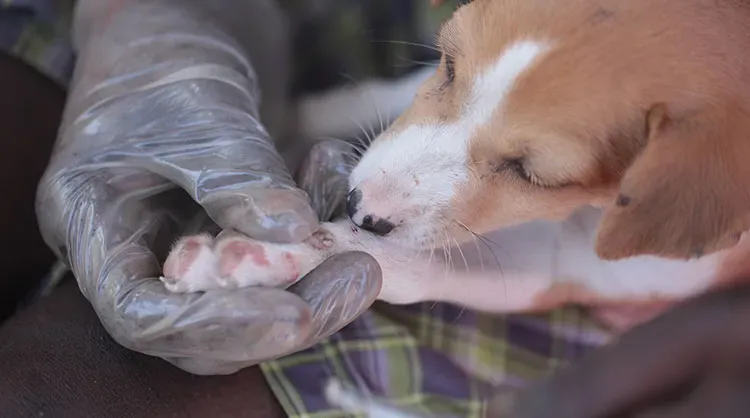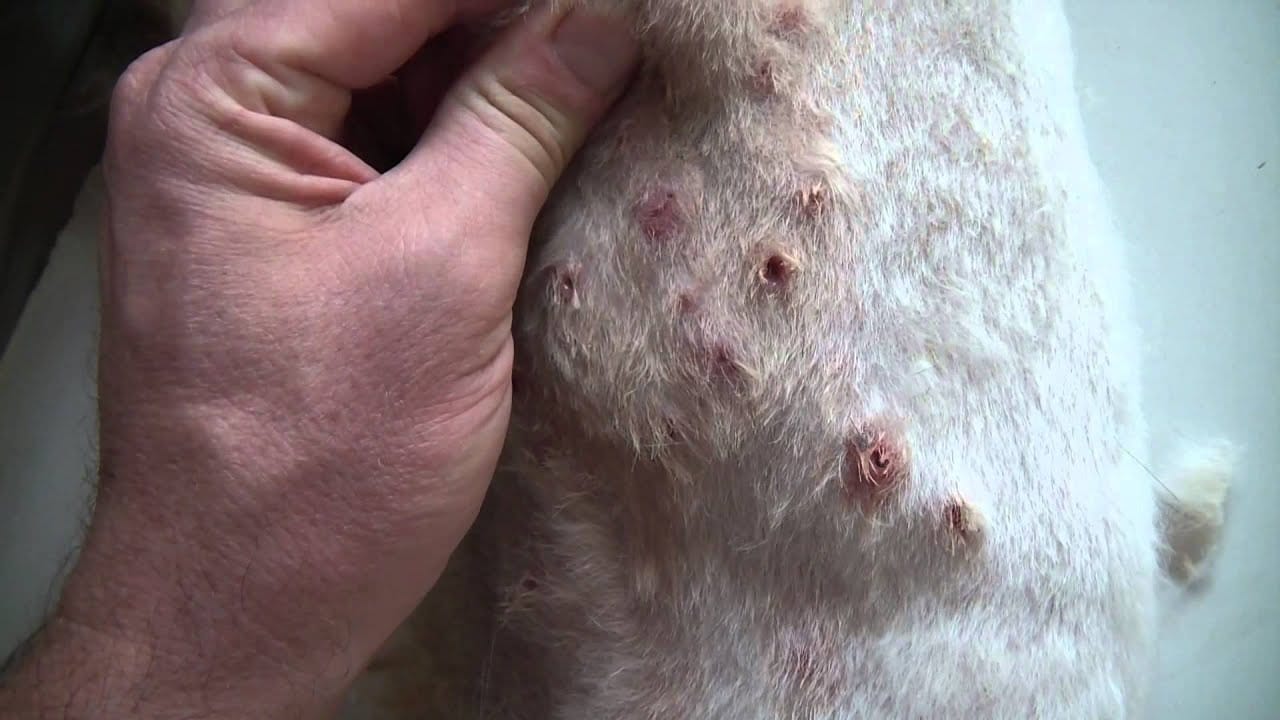Mango worms, also known as Cordylobia anthropophaga, are a type of parasite that infest animals, including humans. These worms are commonly found in sub-Saharan Africa and are known to cause discomfort and pain to their hosts. The infestation usually occurs when the larvae of the mango fly, which is the adult form of the worm, burrow into the skin of the host.

The mango worm infestation can cause a range of symptoms, including itching, swelling, and pain around the area where the worm has burrowed into the skin. The infestation can also lead to the formation of a boil-like lesion, which can be filled with pus. While the infestation is not usually life-threatening, it can be a cause of discomfort and distress to those affected.
Parasites like mango worms are a common occurrence in many parts of the world, and it is crucial to take precautions to avoid infestation. Simple measures such as wearing protective clothing, using insect repellent, and keeping the skin clean and dry can help decrease the risk of infestation. Here, we will explore the causes, symptoms, and treatment options for mango worm infestation, and provide tips on how to prevent infestation.

Biology and Life Cycle
Mango Fly
The mango worm is the larval stage of the Cordylobia anthropophaga, commonly known as the tumbu fly or skin maggot fly. This fly is found in sub-Saharan Africa and is known to infest humans and animals. The adult fly lays eggs on soil, clothing, or other materials that come in contact with the skin of the host.
Larval Development
Once the eggs hatch, the larvae burrow into the skin of the host and begin to feed on tissue and bodily fluids. The larvae grow rapidly and can reach up to 2 cm in length within a few days. As they feed, they create a breathing hole on the surface of the skin, which allows them to breathe while they are inside the host.
Mature Mango Worm
After approximately 8-12 days of feeding, the mature mango worm leaves the host's skin and falls to the ground to pupate. The pupal stage lasts for about 8-10 days before the adult fly emerges. The entire life cycle from egg to adult takes approximately 3-4 weeks.
The mango worm infestation can cause various symptoms, including itching, pain, and swelling. In severe cases, it can lead to secondary bacterial infections and other complications. It is important to seek medical attention if you suspect a mango worm infestation.
Therefore, the mango worm is a parasitic insect that infests humans and animals in sub-Saharan Africa. Its life cycle involves the egg, larval, pupal, and adult stages. The larvae feed on the tissue and bodily fluids of the host and create a breathing hole on the surface of the skin. It is important to take preventive measures and seek medical attention if you suspect a mango worm infestation.
Geographical Distribution
Mango worms, also known as Cordylobia anthropophaga, are a type of parasitic worm that affects animals, including humans. These worms are commonly found in Africa, and they are prevalent in certain regions. However, they have also been reported in other parts of the world due to global travel and spread.
Prevalence in Africa
Mango worms are primarily found in sub-Saharan Africa, particularly in regions with warm and humid climates. The worms are commonly found in rural areas where people live near animals. The larvae of the mango worm burrow into the skin of animals, including dogs, cats, and livestock, causing a painful and itchy infection.
Cases in the United States
While mango worms are not native to the United States, there have been a few reported cases in recent years. These cases have been linked to travel to regions where mango worms are prevalent, such as sub-Saharan Africa. In some cases, people have brought infected animals into the country, leading to the spread of the worms.
Global Travel and Spread
Due to global travel and trade, mango worms have been reported in other parts of the world, including South America and Asia. Travelers who visit regions where mango worms are prevalent are at risk of contracting the infection. It is critical to take precautions, such as wearing protective clothing and using insect repellent, to avoid exposure to the worms.
Thus, mango worms are primarily found in sub-Saharan Africa, but they have also been reported in other parts of the world due to global travel and spread. Travelers should take precautions to avoid exposure to the worms, and people living in regions where mango worms are prevalent should seek treatment if they or their animals are infected.
Transmission and Hosts
Mango worms are parasitic larvae that infect a variety of mammalian hosts. The larvae are transmitted through contact with contaminated soil, bedding, feces, or urine of infected animals.
Typical Hosts
Mango worms are commonly found in dogs, particularly in spots with poor hygiene and sanitation. However, they can also infect other mammalian hosts such as cats, rodents, and livestock.
Human Infestation
Although rare, mango worms can also infest humans. Human infestation occurs when the larvae come into contact with exposed skin, usually through direct contact with contaminated soil or through contact with infected animals.
Animal Hosts
Mango worms are known to infect a wide range of animal hosts. In dogs, they typically infest the skin around the head, neck, and limbs. In cats, they are commonly found on the ears and tail. In livestock, they can be found on the udders, teats, and genitals.
To prevent mango worm infestation, it is vital to maintain good hygiene and sanitation practices, especially in areas where infected animals are present. Regular cleaning of animal bedding and immediate removal of feces and urine can help reduce the risk of transmission.

Symptoms and Diagnosis
Recognizing Symptoms
Mango worms can cause a range of symptoms in infected animals. The most common symptom is the appearance of raised bumps or lesions on the skin. These bumps may be accompanied by redness, swelling, and discomfort. Infected animals may also experience itching and pain around the affected area.
In some cases, mango worm infections can lead to the formation of boils or open wounds. These wounds may become infected, which can cause additional symptoms such as fever and general malaise.
Diagnostic Procedures
Diagnosing a mango worm infection typically involves a physical examination of the animal. The veterinarian may look for signs of skin lesions, bumps, or other abnormalities on the skin. They may also ask about the animal's symptoms and medical history.
In some cases, the veterinarian may need to take a sample of the infected tissue for further analysis. It may involve a biopsy or the collection of skin scraping. These samples can be examined under a microscope to confirm the presence of mango worm larvae.
Overall, early diagnosis and treatment of mango worm infections is significant to prevent complications and ensure a full recovery.
Treatment and Removal
Medical Treatment
In most cases, medical treatment is necessary to treat mango worm infestation. Antibiotics may be prescribed to prevent infection and promote healing of the wound. In some cases, a tetanus shot may also be required to prevent tetanus infection.
Surgical Removal
Surgical removal is often the most effective way to remove mango worms. A doctor will use forceps to grasp the worm and gently pull it out of the wound. In some cases, a small incision may be made to remove the worm.
Home Remedies
While home remedies may provide temporary relief, they are not recommended as a long-term solution for mango worm removal. Petroleum jelly or other substances may be applied to the wound to suffocate the worm and promote its expulsion. However, these remedies may cause complications such as infection or tissue damage.

It is required to seek medical attention if you suspect you have a mango worm infestation. Attempting to remove the worm yourself may cause further complications and make the situation worse. A doctor can provide safe and effective treatment to remove the worm and control infection. In some cases, hydraulic expulsion may also be used to remove the worm.
Prevention and Control
Preventative Measures
Preventing the infestation of mango worms requires taking certain precautions. People living in or traveling to areas where mango flies are prevalent should wear protective clothing, such as long-sleeved shirts and pants, to reduce the risk of exposure. It is also recommended to use insect repellent on exposed skin.
Grooming and hygiene are also essential in preventing mango worm infestations. Regular bathing and cleaning of the skin is help to remove mango fly eggs before they hatch and penetrate the skin. Keeping living areas clean and free of rotting fruits is also necessary, which can attract mango flies.
Environmental Control
Environmental control is another effective way to prevent and control mango worm infestations. It involves eliminating the breeding grounds of mango flies, such as rotting fruits and vegetables, animal feces, and other organic matter. Proper waste disposal and regular cleaning of living areas can help to reduce the number of mango flies in the environment.
Personal Protection
Personal protection is also crucial in preventing mango worm infestations. When traveling to areas where mango flies are prevalent, it is critical to take precautions such as wearing protective clothing and using insect repellent. If an infestation does occur, it is significant to seek medical attention immediately to prevent further complications.
Hence, preventing and controlling mango worm infestations requires a combination of preventative measures, environmental control, and personal protection. By taking these steps, individuals can reduce their risk of exposure to mango flies and the resulting infestation of mango worms.
Impact on Public Health
Disease Transmission
Mango worms, also known as cutaneous myiasis, are a type of parasitic infection caused by the larvae of the mango fly. These flies are commonly found in sub-Saharan Africa and are known to lay their eggs on soil, clothing, and other materials that come in contact with human skin. When the eggs hatch, the larvae burrow into the skin and cause painful lesions.
If left untreated, mango worm infections can lead to bacterial infections and other serious health complications. The larvae can also migrate to other parts of the body and cause further damage. As a result, it is necessary to seek medical attention as soon as possible if you suspect you have a mango worm infection.
Economic Burden
In addition to the health risks associated with mango worm infections, there is also an economic burden associated with these parasites. Infected individuals may be unable to work or perform daily activities, leading to lost productivity and income. Treatment for mango worm infections can also be expensive, particularly in areas where access to healthcare is limited.
Furthermore, mango worm infections can harm tourism and other industries. Visitors to affected regions may be deterred by the risk of infection, leading to a decline in tourism revenue. As a result, public health officials need to take steps to prevent and control mango worm infections to minimize their economic impact.
Advice for Pet Owners
Recognizing Infestations
Mango worms are a common concern for dogs in tropical and subtropical regions. Pet owners should be aware of the signs of infestations, which include itching, scratching, and the appearance of small bumps or lumps on the skin. These bumps may become red and inflamed, and may even rupture, releasing a creamy white substance. If you notice any of these symptoms, it is essential to take your pet to the vet as soon as possible.
Veterinary Care
If your pet is diagnosed with a mango worm infestation, your vet will likely recommend treatment with a topical or oral medication. In some cases, the worms may need to be removed surgically. It is required to follow your vet's instructions carefully and to continue treatment until the infestation is completely resolved. Regular check-ups with your vet can help prevent future infestations.

Regular Pet Maintenance
Regular grooming can help prevent mango worm infestations. Be sure to brush your dog's coat regularly to remove any loose hair, dirt, or debris. It can help prevent fleas and ticks from taking up residence on your pet's skin. Additionally, discourage your pet from licking or biting at any bumps or lumps on their skin, as this can cause further irritation and may lead to infection.
Conclusion
In conclusion, while mango worm infestations can be a nuisance for pet owners, they can be effectively treated with the help of a veterinarian. By recognizing the signs of infestations, seeking prompt veterinary care, and maintaining good grooming habits, pet owners can help keep their furry friends healthy and happy.






